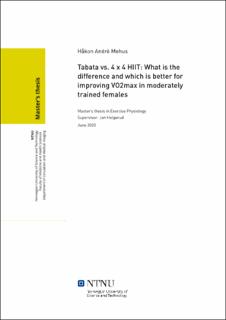| dc.description.abstract | Aim: the aim of the present study was to investigate the effect of 4 x 4 high-intensity interval
training (HIIT) versus running Tabata on endurance performance and it`s determinants in
moderately trained females. Methods: 26 healthy, non-smoking recreationally endurance
trained females were randomized to complete HIIT (N=13) or Tabata (N=13) for three times a
week over 8 weeks. Both modalities included treadmill running, HIIT was performed as 4x4
minutes intervals at 90-95% (HRmax) interspersed with 3-minute active recovery at ~70% HRmax
between intervals. Tabata was performed as 8x20 seconds supramaximal intensity intermittent
training separated with a 10 second rest. Results: No significant group difference was observed
between groups in VO2max from pre- to post testing. VO2max increased by 4.2 % after HIIT (51.4- 53.5 mL∙kg-1∙min-1), no change occurred in Tabata. Improvements in VO2max was connected to a
4.1 % increase in O2 pulse ensuing HIIT. Work economy (C) improved significantly following
both HIIT and Tabata with no significant difference between the groups. Maximal accumulated oxygen deficit MAOD improved significantly 10.4% (69.4-76.0 mL∙kg-1∙min-1) ensuing Tabata,
while changes were not significant after HIIT. 3000-meter performance was significantly
improved by 4.6 % (911-870 seconds) following HIIT and 4.5% (870-830 seconds) following
Tabata, with no significant difference between the groups. 300-meter performance improved
significantly more after Tabata. Within groups the improvements were 2.2% (56.4-55.1
seconds) after HIIT and 5.6% (57.7- 54.3 seconds) after Tabata. Conclusion: Tabata is an
ineffective approach to improve VO2max in moderately trained females compared with HIIT.
However, when evaluating anaerobic capacity as MAOD and anaerobic performance on 300
meter run Tabata were superior to HIIT. | |
